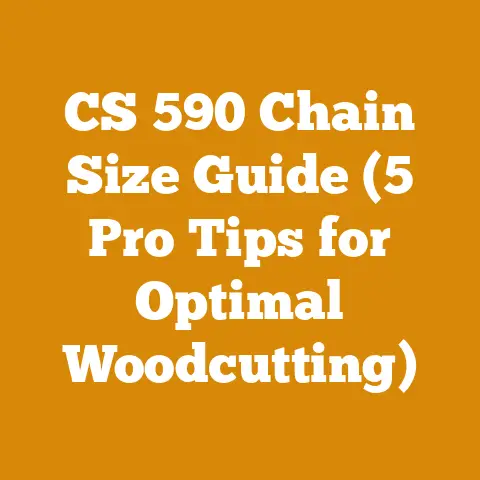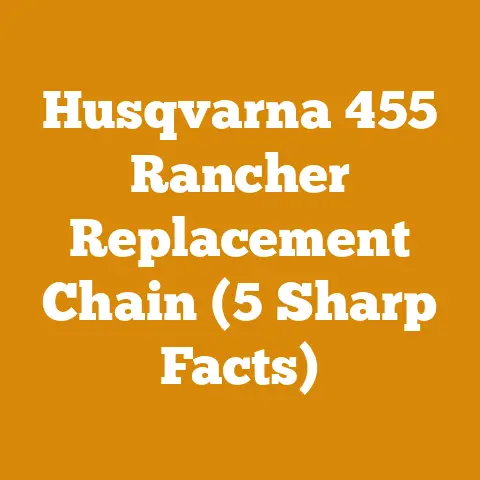How Many Board Feet in a Cord of Wood (5 Expert Tips)
Here’s a best-kept secret many seasoned woodworkers and loggers won’t readily share: understanding the relationship between a cord of wood and board feet is crucial for accurate project budgeting. It’s a bit like knowing the secret handshake in the world of wood. I’ve seen countless folks, myself included, get caught off guard by miscalculations, leading to budget overruns and project delays. Let’s unravel this mystery together, armed with data, practical tips, and a few personal anecdotes from my years in the wood processing game.
How Many Board Feet in a Cord of Wood (5 Expert Tips)
Navigating the world of wood measurements can feel like wading through a dense forest. You’ve got cords, board feet, cubic feet, and even terms like “rick” and “face cord” thrown into the mix. But don’t worry, I’m here to guide you through. The core question we’re tackling today is: how many board feet are actually hiding within a cord of wood? While the answer isn’t a simple one-size-fits-all number, I will give you the tools and knowledge to estimate it accurately for your specific needs.
Understanding the Cord: A Foundation
Before diving into board feet, let’s solidify our understanding of a cord. A standard cord of wood is defined as a neatly stacked pile measuring 4 feet high, 4 feet wide, and 8 feet long. This equates to 128 cubic feet. However, and this is critical, not all of that space is solid wood. Air gaps between the logs significantly reduce the actual wood volume. This is where the complexity begins.
Board Feet Defined
A board foot is a unit of volume equal to a piece of wood 1 inch thick, 12 inches wide, and 12 inches long. Imagine a ruler, but three-dimensional. It’s a common unit for pricing lumber, especially hardwoods. Converting cords to board feet allows you to compare the cost of firewood to the cost of milled lumber, a crucial skill for any serious woodworker.
Estimating Board Feet: The Variable Equation
The relationship between a cord and board feet is not fixed. It’s influenced by several factors:
- Wood Species: Hardwoods, like oak and maple, are denser than softwoods, such as pine and fir. A cord of hardwood will generally yield more board feet than a cord of softwood.
- Log Straightness and Size: Straight, uniformly sized logs pack more efficiently, reducing air gaps and increasing the solid wood content within the cord. Crooked or oddly shaped logs decrease the yield.
- Stacking Method: A tightly packed cord will contain more wood than a loosely stacked one. The care taken during stacking directly impacts the volume of wood.
- Moisture Content: Green wood is heavier and denser than seasoned wood. While the actual volume remains the same, the weight difference can be significant, and for some applications, moisture content affects usability. This doesn’t directly affect board feet, but it’s a crucial consideration.
- Bark Thickness: Thick-barked species like oak will have less usable wood volume compared to smooth-barked species like maple, assuming the same overall log dimensions.
General Estimates and Data Points
While a precise conversion is impossible without considering the above factors, we can provide some general estimates based on industry data and my own experience.
- Average Range: A cord of wood typically yields between 350 and 600 board feet. This is a wide range, highlighting the importance of considering the specific characteristics of the wood you’re working with.
- Softwoods (Pine, Fir): Expect around 350-450 board feet per cord.
- Hardwoods (Oak, Maple, Cherry): Expect around 500-600 board feet per cord.
Data Points & Sources:
- The US Forest Service estimates that a cord of mixed hardwoods typically contains around 500 board feet of usable lumber after processing.
- Various state forestry agencies publish guides on firewood measurements, often citing similar ranges for board foot conversion. (e.g., check your state’s Department of Natural Resources website).
- Lumber price indices (like those tracked by Random Lengths) can help you compare the cost per board foot of milled lumber to the estimated cost per board foot of your firewood.
Personal Story: I once purchased what I thought was a fantastic deal on a cord of “mixed hardwoods.” However, upon closer inspection, it turned out to be mostly crooked, knotty aspen. The yield was far lower than I anticipated – closer to 300 board feet. This taught me a valuable lesson about the importance of careful inspection before purchasing.
5 Expert Tips for Estimating and Maximizing Board Feet
Here are five expert tips, gleaned from years of experience, to help you estimate board feet more accurately and maximize your yield from each cord of wood:
Tip 1: Species Identification is Key
Knowing your wood species is paramount. As mentioned earlier, hardwoods generally yield more board feet due to their higher density. Use a field guide or online resources to accurately identify the species in your cord. If it’s a mixed cord, estimate the percentage of each species to refine your overall board foot estimate.
Actionable Step: Before buying, ask the seller for the species composition of the cord. If they can’t provide this information, be wary. If you’ve already purchased the cord, take the time to identify the different species present.
Tip 2: Evaluate Log Straightness and Size Distribution
Examine the logs carefully. Are they relatively straight and uniform in size, or are they crooked and wildly varying in diameter? Straight, consistently sized logs will pack more efficiently, reducing air gaps and increasing the usable wood volume.
Actionable Step: Visually assess the cord. Estimate the percentage of logs that are straight and uniform versus those that are crooked or oddly shaped. Adjust your board foot estimate accordingly. For example, if half the logs are significantly crooked, reduce your initial estimate by 10-15%.
Tip 3: Master the Art of Stacking (Even if You’re Not the One Stacking)
Even if you’re buying pre-cut firewood, the way it’s stacked impacts the volume. A tightly packed cord contains more wood than a loosely stacked one. If you are stacking the cord yourself, take the time to do it properly. If you’re buying a cord, visually inspect the stacking.
Actionable Step: If you’re stacking, use a consistent stacking pattern. Aim to minimize air gaps. If you’re buying a cord, look for tightly packed stacks. A loosely stacked cord is a red flag that you might be getting less wood than you’re paying for.
Tip 4: Consider Moisture Content (Indirectly)
While moisture content doesn’t directly affect the number of board feet, it does affect the weight and workability of the wood. Green wood is heavier and harder to work with. Seasoned wood is lighter and easier to cut and split.
Actionable Step: If you’re planning to mill the wood into lumber, allow it to dry properly. Aim for a moisture content of around 12-15% for general woodworking. Use a moisture meter to accurately measure the moisture content. Proper drying will also minimize warping and cracking, maximizing your usable board feet.
Tip 5: Embrace Technology: Volume Calculators
Several online tools and apps can help you estimate the volume of logs in board feet or cubic feet. These calculators typically require you to input the log’s diameter and length. While they don’t account for air gaps in a cord, they can provide a valuable starting point for your estimation.
Actionable Step: Use a log volume calculator (search online for “log volume calculator”) to estimate the board footage of a few representative logs from your cord. Average the results to get a rough estimate for the entire cord. Remember to adjust this estimate based on species, straightness, and stacking.
Cost Analysis: From Cord to Project
Now that we have a better understanding of how to estimate board feet in a cord, let’s delve into the cost analysis. This is where things get really interesting, and where understanding the cord-to-board-foot conversion can save you serious money.
Cost Components: A Detailed Breakdown
When evaluating the cost of using firewood for woodworking projects, consider these components:
- Timber Purchase (or Harvesting Costs): This is the initial cost of the cord of wood. Prices vary widely depending on location, species, and seller.
- Transportation Costs: Getting the wood from the seller to your workshop. This can include fuel costs, truck rental, or delivery fees.
- Processing Costs (If Applicable): This includes the cost of milling the logs into lumber. This could involve hiring a portable sawmill or using your own milling equipment.
- Tool Costs (Chainsaw, Mill, etc.): The cost of purchasing and maintaining the necessary tools. This includes chainsaws, sawmills, blades, sharpening equipment, and safety gear.
- Labor Costs (If Applicable): If you’re hiring someone to help with processing, factor in their hourly rate.
- Drying Costs: The cost of storing and drying the lumber. This could include the cost of building a kiln or simply the cost of the space required for air drying.
- Waste Disposal: The cost of disposing of sawdust, bark, and other waste materials.
Data Points & Benchmarks
- Average Price per Cord: The average price of a cord of firewood in the US ranges from \$150 to \$400, depending on location and species (Source: Various state forestry agencies and firewood vendors).
- Portable Sawmill Rental: Renting a portable sawmill typically costs between \$200 and \$500 per day (Source: Equipment rental companies).
- Sawmill Labor: Hiring a sawmill operator typically costs between \$50 and \$100 per hour (Source: Independent sawmill operators).
- Lumber Prices: Prices for milled lumber vary widely depending on species, grade, and thickness. Check local lumberyards for current prices.
Cost Comparison Table (Example):
| Item | Cost (USD) | Notes |
|---|---|---|
| Cord of Oak Firewood | \$300 | Assumes a good quality cord of seasoned oak. |
| Transportation | \$50 | Assumes a short-distance truck rental. |
| Sawmill Rental | \$300 | Assumes a one-day rental of a portable sawmill. |
| Labor (Sawmill) | \$200 | Assumes 4 hours of labor at \$50/hour. |
| Total Cost | \$850 | This is the estimated cost to convert one cord of firewood into lumber. |
| Board Feet Yield | 550 | Estimated based on species, log quality, and stacking. |
| Cost per Board Foot | \$1.55 | \$850 / 550 board feet. Compare this to the price of buying milled oak lumber. |
Important Note: This is just an example. Your actual costs will vary depending on your specific circumstances.
Budgeting and Cost Optimization
Here are some practical tips for managing costs:
- Shop Around for Firewood: Get quotes from multiple vendors to find the best price.
- Consider Off-Season Purchases: Firewood prices often drop in the spring and summer.
- Negotiate with the Seller: Don’t be afraid to haggle, especially if you’re buying in bulk.
- Do Some of the Work Yourself: If you have the skills and equipment, consider milling the lumber yourself to save on labor costs.
- Optimize Drying Time: Proper stacking and ventilation can significantly reduce drying time, saving you storage costs.
- Minimize Waste: Carefully plan your cuts to minimize waste and maximize the usable lumber yield.
- Barter or Trade: Consider bartering your woodworking skills for firewood or milling services.
Personal Story: I once saved a considerable amount of money by purchasing a “downed tree” from a local farmer. The tree had fallen during a storm, and the farmer was happy to get rid of it. I milled the tree into lumber myself, saving on both timber purchase and milling costs. This required more effort, but the savings were well worth it.
Calculations and Formulas
While precise calculations are difficult, here are some useful formulas:
- Board Foot Calculation (Individual Log): (Length in feet * Diameter in inches * Diameter in inches) / 144. This is a simplified formula for estimating board feet in a log.
- Cubic Feet to Board Feet (Approximation): Cubic feet * 12 = Approximate board feet. This is a very rough approximation and doesn’t account for air gaps or species density.
- Drying Time Estimation: Drying time depends on species, thickness, and environmental conditions. As a general rule, air-drying lumber takes about one year per inch of thickness in most climates.
Challenges Faced by Small-Scale Loggers and Firewood Suppliers
Small-scale loggers and firewood suppliers face numerous challenges, including:
- Fluctuating Timber Prices: Timber prices can be volatile, making it difficult to predict profitability.
- Competition from Larger Operations: Large-scale logging operations often have economies of scale that small businesses can’t match.
- Regulatory Compliance: Complying with logging regulations and environmental permits can be costly and time-consuming.
- Equipment Costs: The cost of purchasing and maintaining logging equipment can be a significant barrier to entry.
- Labor Shortages: Finding skilled labor can be challenging, especially in rural areas.
- Seasonality: Firewood sales are often seasonal, leading to income fluctuations.
Actionable Advice: If you’re a small-scale logger or firewood supplier, focus on niche markets, such as supplying specialty hardwoods to woodworkers or providing custom milling services. Build strong relationships with your customers and provide excellent service to differentiate yourself from larger competitors.
Actionable Takeaways and Next Steps
You’ve now armed yourself with knowledge to navigate the world of cords and board feet. The journey doesn’t end here.
- Assess Your Needs: Determine your specific woodworking or firewood needs. What species of wood do you require? How many board feet do you need?
- Research Local Prices: Contact local firewood vendors and lumberyards to compare prices.
- Inspect Before You Buy: Carefully inspect the wood before purchasing it. Look for species, straightness, size, and stacking quality.
- Calculate Your Costs: Use the cost analysis framework outlined above to estimate your total costs.
- Start Small: If you’re new to wood processing, start with a small project to gain experience and refine your skills.
Conclusion: The Wood Whisperer’s Secret
Understanding the relationship between cords and board feet is more than just a mathematical exercise; it’s about making informed decisions, optimizing your budget, and maximizing the value of your wood resources. It’s about becoming a “wood whisperer,” able to discern the potential hidden within a pile of logs. With these expert tips and a little practice, you’ll be well on your way to mastering the art of wood processing and firewood preparation. Remember, knowledge is power, and in the world of wood, that power translates directly into savings and successful projects.






